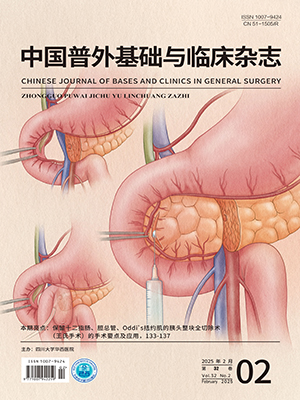| 1. |
Weiss SW, Enzinger FM. Epithelioid hemangioendothelioma: a vascular tumor often mistaken for a carcinoma. Cancer, 1982, 50(5): 970-981.
|
| 2. |
Ishak KG, Sesterhenn IA, Goodman ZD, et al. Epithelioid hemangioendothelioma of the liver: a clinicopathologic and follow-up study of 32 cases. Hum Pathol, 1984, 15(9): 839-852.
|
| 3. |
Makhlouf HR, Ishak KG, Goodman ZD. Epithelioid hemangioendothelioma of the liver: a clinicopathologic study of 137 cases. Cancer, 1999, 85(3): 562-582.
|
| 4. |
Christopher DM, Fletcher, Julia A, et al. WHO classification of tumours of soft tissue and bone. Lyon:IARC Press, 2013: 155-156.
|
| 5. |
张树辉, 丛文铭, 吴孟超.肝上皮样血管内皮瘤的临床病理特点(附8例报告及文献复习).中华肝胆外科杂志, 2003, 9(6): 327-330.
|
| 6. |
Mehrabi A, Kashfi A, Fonouni H, et al. Primary malignant hepatic epithelioid hemangioendothelioma: a comprehensive review of the literature with emphasis on the surgical therapy. Cancer, 2006, 107(9): 2108-2121.
|
| 7. |
Lauffer JM, Zimmermann A, Krahenbuhl L, et al. Epithelioid hemangioendothelioma of the liver. A rare hepatictumor. Cancer, 1996, 78(11): 2318-2327.
|
| 8. |
Hayashi Y, Inagaki K, Hirota S, et al. Epithelioid hemangioendothelioma with marked liver deformity and secondary Budd-Chiari syndrome: pathological and radiological correlation. Pathol Int, 1999, 49(6): 547-552.
|
| 9. |
Komatsu Y, Koizumi T, Yasuo MA, et al. Malignant hepatic epithelioid hemangioendothelioma with rapid progression and fatal outcome. Intern Med, 2010, 49(12): 1149-1153.
|
| 10. |
Zis P, Assi A, Kravaritis D, et al. Ischemic stroke as the first manifestation of hepatic epithelioid hemangioendothelioma. J Stroke Cerebrovasc Dis, 2014, 23(3): e237-e240.
|
| 11. |
Hsieh MS, Liang PC, Kao YC, et al. Hepatic epithelioid hemangioendothelioma in Taiwan: a clinicopathologic study of six cases in a single institution over a 15-year period. J Formos Med Assoc, 2010, 109(3): 219-227.
|
| 12. |
Thin LW, Wong DD, De Boer BW et al. Hepatic epithelioid haemangioendothelioma: challenges in diagnosis and management. Intern Med J, 2010, 40(10): 710-715.
|
| 13. |
赵爱莲, 周立新, 李向红.肝脏上皮样血管内皮瘤穿刺标本的病理诊断与鉴别诊断.中华病理学杂志, 2011, 40(1): 23-26.
|
| 14. |
Christopher DM, Fletcher K, Krishnan U.软组织与骨肿瘤病理学和遗传学.北京:人民卫生出版社, 2006: 199-202.
|
| 15. |
Liu YI, Brown SS, Elihu A, et al. Hepatic epithelioid hemangioendothelioma. Dig Dis Sci, 2011, 56(2): 303-306.
|
| 16. |
Emamaullee JA, Edgar R, Toso C, et al. Vascular endothelial growth factor expression in hepatic epithelioid hemangioendothelioma: Implications for treatment and surgical management. Liver Transpl, 2010, 16(2): 191-197.
|
| 17. |
Fujii T, Zen Y, Sato Y, et al. Podoplanin is a useful diagnostic marker for epithelioid hemangioendothelioma of the liver. Mod Pathol, 2008, 21(2): 125-130.
|
| 18. |
Errani C, Zhang L, Sung YS, et al. A novel WWTR1-CAMTA1 gene fusion is a consistent abnormality in epithelioid hemangioendothelioma of different anatomic sites. Genes Chromosomes Cancer, 2011, 50(8): 644-653.
|
| 19. |
Antonescu CR, Le Loarer F, Mosquera JM, et al. Novel YAP1-TFE3 fusion defines a distinct subset of epithelioid hemangioendothelioma. Genes Chromosomes Cancer, 2013, 52(8): 775-784.
|
| 20. |
Lerut JP, Orlando G, Adam R, et al. The place of liver transplantation in the treatment of hepatic epitheloid hemangioendothelioma: report of the European liver transplant registry. Ann Surg, 2007, 246(6): 949-957.
|
| 21. |
Mascarenhas RC, Sanghvi AN, Friedlander L, et al. Thalidomide inhibits the growth and progression of hepatic epithelioid hemangioendothelioma. Oncology, 2004, 67(5-6): 471-475.
|
| 22. |
Sangro B, Iñarrairaegui M, Fernández-Ros N. Malignant epithelioid hemangioendothelioma of the liver successfully treated with Sorafenib. Rare Tumors, 2012, 4(2): e34.
|
| 23. |
Hertl M, Cosimi AB. Liver transplantation for malignancy. Oncologist, 2005, 10(4): 269-281.
|
| 24. |
Wang LR, Zhou JM, Zhao YM, et al. Clinical experience with primary hepatic epithelioid hemangioendothelioma: retrospective study of 33 patients. World J Surg, 2012, 36(11): 2677-2683.
|
| 25. |
Choi KH, Moon WS. Epithelioid hemangioendothelioma of the liver. Clin Mol Hepatol, 2013, 19(3): 315-319.
|




